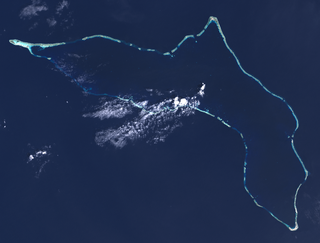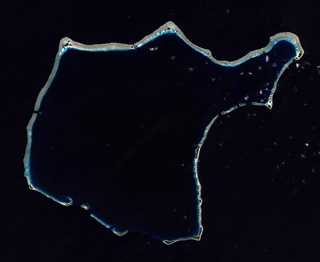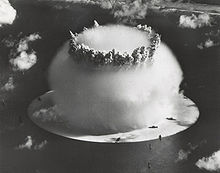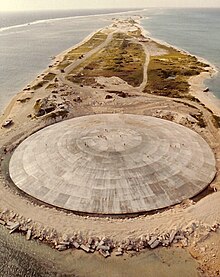
The Marshall Islands, officially the Republic of the Marshall Islands, is an island country west of the International Date Line and north of the equator in the Micronesia region of the Northwestern Pacific Ocean.
The demographics of the Marshall Islands include data such as population density, ethnicity, health of the populace, economic status, religious affiliations and other aspects of the population.

Kwajalein Atoll is part of the Republic of the Marshall Islands (RMI). The southernmost and largest island in the atoll is named Kwajalein Island, which its majority English-speaking residents often use the shortened name, Kwaj. The total land area of the atoll amounts to just over 6 square miles (16 km2). It lies in the Ralik Chain, 2,100 nautical miles southwest of Honolulu, Hawaii.

Bikini Atoll, known as Eschscholtz Atoll between the 19th century and 1946, is a coral reef in the Marshall Islands consisting of 23 islands surrounding a 229.4-square-mile (594.1 km2) central lagoon. The atoll is at the northern end of the Ralik Chain, approximately 530 miles (850 km) northwest of the capital Majuro.

Enewetak Atoll is a large coral atoll of 40 islands in the Pacific Ocean and with its 296 people forms a legislative district of the Ralik Chain of the Marshall Islands. With a land area total less than 5.85 square kilometers (2.26 sq mi), it is no higher than 5 meters (16.4 ft) and surrounds a deep central lagoon, 80 kilometers (50 mi) in circumference. It is the second-westernmost atoll of the Ralik Chain and is 305 kilometers (190 mi) west from Bikini Atoll.

Ebeye is the populous island of Kwajalein Atoll in the Marshall Islands, and the second most populated in the Marshall Islands. It is a center for Marshallese culture in the Ralik Chain of the archipelago. Settled on 80 acres of land, it 2021 it had a population of 8,416. Over 50% of the population is estimated to be under the age of 18.

The Compacts of Free Association (COFA) are international agreements establishing and governing the relationships of free association between the United States and the three Pacific Island sovereign states of the Federated States of Micronesia (FSM), the Republic of the Marshall Islands (RMI), and the Republic of Palau. As a result, these countries are sometimes known as the Freely Associated States (FASs). All three agreements next expire in 2043.

Rongelap AtollRONG-gə-lap is an uninhabited coral atoll of 61 islands in the Pacific Ocean, and forms a legislative district of the Ralik Chain of the Marshall Islands. Its total land area is 8 square miles (21 km2). It encloses a lagoon with an area of 1,000 square miles (2,600 km2). It is historically notable for its close proximity to US hydrogen bomb tests in 1954, and was particularly devastated by fallout from the Castle Bravo test. The population asked the US to move them from Rongelap following the test due to high radiation levels, but with no success; so they asked global environmental group Greenpeace to help. The Rainbow Warrior made three trips moving the islanders, their possessions and over 100 tons of building materials to the island of Mejato in the Kwajalein Atoll, 180 kilometers away.

Rongerik Atoll or Rongdrik Atoll is an unpopulated coral atoll of 17 islands in the Pacific Ocean, and is located in the Ralik Chain of the Marshall Islands, approximately 200 kilometers (120 mi) east of Bikini Atoll. Its total land area is only 1.68 square kilometers (0.65 sq mi), but it encloses a lagoon of 144 square kilometers (56 sq mi).

Kili Island or Kili Atoll is a small, 81 hectares island located in the Marshall Islands in the Pacific Ocean. As of 2021, 415 people lived on the island, many of whom were descended from islanders who originally lived on Bikini Atoll. They were relocated when they agreed to let the U.S. government temporarily use Bikini for nuclear testing in 1945, which they were told was of great importance to humankind, though it is sometimes considered a forced relocation. Kili Island became their home after two prior relocations failed. The island does not have a natural lagoon and cannot produce enough food to enable the islanders to be self-sufficient. It is part of the legislative district of the Ralik Chain of the Marshall Islands. The island is approximately 48 kilometers (30 mi) southwest of Jaluit. It is a good sized island for the Marshall Islands, but it is not an atoll with a lagoon.

The Pacific Proving Grounds was the name given by the United States government to a number of sites in the Marshall Islands and a few other sites in the Pacific Ocean at which it conducted nuclear testing between 1946 and 1962. The U.S. tested a nuclear weapon on Bikini Atoll on June 30, 1946. This was followed by Baker on July 24, 1946.

The flag of Bikini Atoll, a member of the Marshall Islands, closely resembles the flag of the United States and was adopted in 1987. The flag is symbolic of the islanders' position that a great debt is still owed by the U.S. government to the people of Bikini because in 1954 the United States detonated the Castle Bravo hydrogen bomb on the island, poisoning islanders and others with nuclear fallout.

Marshall Islands–United States relations are bilateral relations between Marshall Islands and the United States.
James Matayoshi is the mayor of Rongelap Atoll in the Marshall Islands. He was appointed as Rongelap's mayor in 1995 and has served as chairman of the Marshall Islands Ports Authority since 2008. As the mayor of Rongelap, Matayoshi was noted for his activism on calling for the United States government to render assistance to Marshall Islanders suffering from radiation sickness as a result of a series of nuclear tests carried out under Operation Castle in the 1950s.
Anjua Loeak was one of the Iroijlaplap of Ailinglaplap, and one of four paramount chiefs in the Ralik Chain. Loeak shared his domain with the Iroijlaplap of Kwajalein, formerly Imata Kabua.

Nuclear testing at Bikini Atoll consisted of the detonation of 23 nuclear weapons by the United States between 1946 and 1958 on Bikini Atoll in the Marshall Islands. Tests occurred at 7 test sites on the reef itself, on the sea, in the air, and underwater. The test weapons produced a combined yield of about 77–78.6 Mt of TNT in explosive power. After the inhabitants agreed to a temporary evacuation, to allow nuclear testing on Bikini, which they were told was of great importance to humankind, two nuclear weapons were detonated in 1946. About ten years later, additional tests with thermonuclear weapons in the late 1950s were also conducted. The first thermonuclear explosion was much more powerful than expected, and created a number of issues, but did demonstrate the dangers of such devices.

India–Marshall Islands relations are the bilateral relations between India and the Marshall Islands. The respective embassies of the two countries in Tokyo, Japan are concurrently accredited to each other. Marshall Islands maintains an Honorary Consulate in New Delhi.

Abacca Anjain-Maddison is a former Senator in the Marshall Islands and is now the Deputy Chief Secretary of the country. She is known as a campaigner against nuclear weapons and nuclear testing and in support of greater efforts by the United States to clean up islands it used for nuclear testing.

Tina Stege is the Climate Envoy for the Marshall Islands (RMI). The RMI is one of the countries in the world most vulnerable to climate change, mainly as a result of rising sea levels. Stege has represented her country at the 2019 United Nations Climate Change Conference (COP25) held in Madrid, Spain, the 2021 Conference (COP26) held in Glasgow, Scotland, the 2022 Conference (COP27) held in Sharm El Sheikh, Egypt, the 2023 Conference (COP28), held in Dubai, and the 2024 Conference (COP29), held in Baku, Azerbaijan. She has also been a spokesperson for the RMI on the impacts of nuclear testing.
There is a population of Marshallese people in Northwest Arkansas, concentrated in Springdale.

















